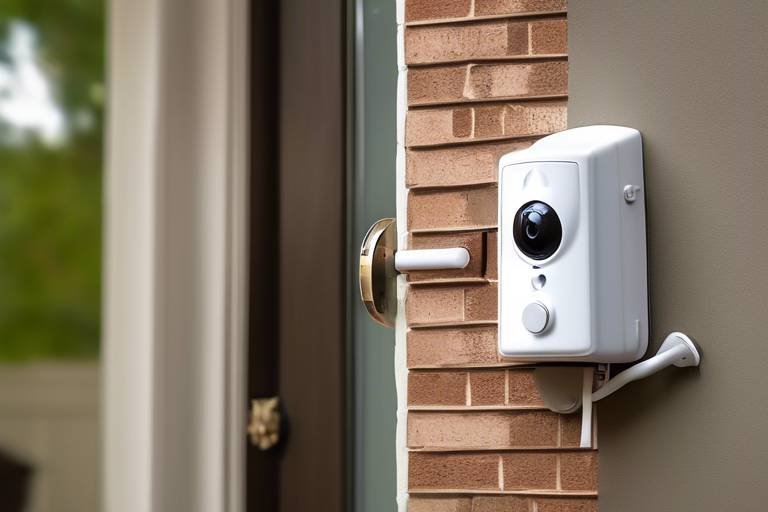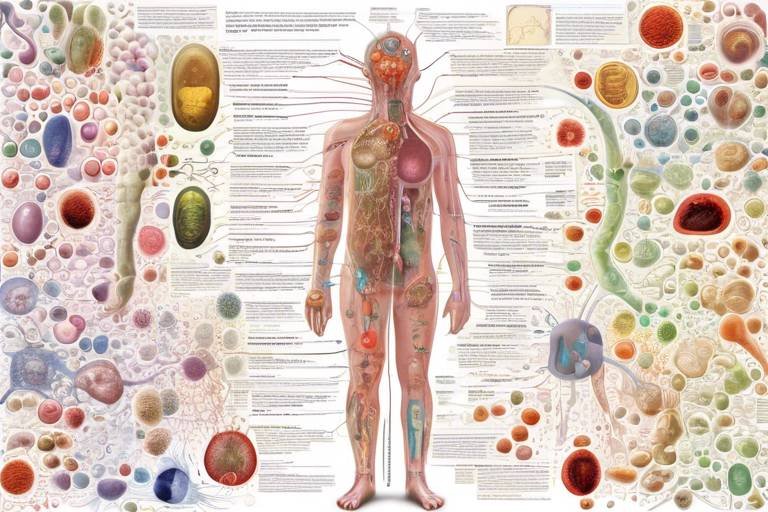How Household Dust Affects Health - The Science Behind It
Have you ever stopped to think about what’s swirling around in your home? It’s easy to overlook, but household dust is more than just a nuisance; it’s a complex cocktail of various particles that can significantly impact our health. From allergens to pollutants, the components of dust can lead to a range of health issues, especially for those with pre-existing conditions. In this article, we’ll dive into the fascinating world of household dust, exploring its composition, the potential health risks it poses, and the science that links dust exposure to respiratory and other health issues. So, let’s get our hands dirty and uncover the truth about what’s lurking in our living spaces!
Household dust is a complex mixture that accumulates in our homes over time. It can include a variety of particles such as skin flakes, hair, textile fibers, and even tiny bits of soil. But that’s not all! Dust often contains a host of other components, including allergens, pollutants, and microorganisms. These particles can be carried in by the wind, tracked in from outside, or generated from our daily activities. Understanding the composition of household dust is crucial because it helps us comprehend the potential health risks associated with prolonged exposure.
When you think of allergens, what comes to mind? For many, it’s pollen or pet dander, and guess what? These are just a couple of the common culprits found in household dust. Dust can harbor a variety of allergens, including:
- Pollen - tiny grains that can trigger hay fever and other allergic reactions.
- Pet Dander - microscopic flakes of skin shed by furry friends.
- Dust Mites - tiny creatures that thrive in warm, humid environments.
These allergens can trigger allergic reactions and asthma symptoms, making it essential to manage dust levels in our homes. The presence of these particles can lead to sneezing, itchy eyes, and even more severe respiratory issues for sensitive individuals.
Now, let’s talk about one of the most notorious players in the dust game: dust mites. These microscopic organisms are not just creepy; they’re also a significant source of allergens in our homes. Dust mites thrive in warm, humid areas, feeding on dead skin cells that we shed daily. Their life cycle consists of several stages, from egg to adult, and they reproduce quickly, leading to large populations in areas like bedding, carpets, and upholstered furniture. For those who are sensitive, exposure to dust mites can result in severe allergic reactions, including asthma attacks.
So, how can we keep these pesky dust mites at bay? Here are some practical tips to minimize dust mite exposure:
- Wash Bedding Regularly: Use hot water to wash sheets and pillowcases weekly.
- Use Allergen-Proof Covers: Encase pillows and mattresses in dust mite-proof covers.
- Maintain Low Humidity: Keep indoor humidity levels below 50% to deter dust mites.
By implementing these strategies, you can create a healthier living environment and reduce the risk of allergic reactions related to dust mites.
Recognizing dust mite allergies is crucial for effective management. Common symptoms include sneezing, runny or stuffy nose, itchy eyes, and even skin rashes. If you suspect you have a dust mite allergy, it’s essential to consult a healthcare professional. They may perform skin tests or blood tests to confirm the allergy, allowing for targeted treatment and management strategies.
But wait, there’s more! Exposure to household dust goes beyond just allergies. It can lead to various health issues, including:
- Respiratory Problems: Prolonged exposure to dust can exacerbate asthma and other respiratory conditions.
- Skin Irritations: Dust can cause skin rashes and irritations, especially in sensitive individuals.
- Other Health Risks: Some studies suggest a link between dust exposure and chronic health issues, including cardiovascular problems.
Understanding these risks is vital for taking proactive measures to protect your health and that of your family.
Regular cleaning is one of the most effective ways to combat dust accumulation in our homes. By incorporating specific cleaning techniques and products, we can create a dust-free environment. Here are some strategies to consider:
- Dust Surfaces Regularly: Use microfiber cloths to trap dust instead of spreading it around.
- Vacuum Frequently: Opt for a vacuum with a HEPA filter to capture allergens effectively.
Vacuuming is a key method for reducing dust, but not all vacuums are created equal. To effectively capture dust and allergens, consider the following:
- Choose the Right Vacuum: Look for vacuums with HEPA filters.
- Vacuum in Multiple Directions: This helps to lift and remove more dust and debris.
By using these techniques, you can significantly improve your indoor air quality and reduce the dust levels in your home.
Finally, let’s not forget about the importance of indoor air quality. Poor air quality can exacerbate the health effects of household dust. To maintain good air quality, consider using air purifiers, ensuring proper ventilation, and regularly changing air filters in your HVAC system. By focusing on both dust reduction and air quality, you can create a healthier living space for you and your family.
Q1: How often should I clean to reduce dust in my home?
A1: It’s recommended to dust surfaces weekly and vacuum at least once a week to keep dust levels low.
Q2: Can household dust cause long-term health issues?
A2: Yes, prolonged exposure to dust can lead to respiratory problems and other chronic health issues, especially in sensitive individuals.
Q3: What are the best types of vacuums for dust removal?
A3: Vacuums with HEPA filters are best for capturing dust and allergens effectively.

Understanding Household Dust
Household dust is not just a nuisance that settles on your furniture; it is a complex mixture of various particles that can significantly impact your health. Imagine a tiny world existing right under your nose, made up of everything from skin cells to pollen, and even tiny insects! Yes, that's right—dust is a cocktail of materials that we often overlook. This mixture can include allergens, pollutants, and microorganisms that may pose serious health risks, particularly for those with sensitive respiratory systems.
To truly understand what household dust consists of, let’s break it down into its primary components. The most common elements found in dust include:
- Human Skin Cells: Did you know that humans shed millions of skin cells every day? These cells contribute significantly to household dust.
- Pet Dander: If you have furry friends at home, their dander can be a major allergen found in dust.
- Pollen: Seasonal changes bring in pollen from trees, grasses, and weeds, which can easily find its way indoors.
- Dust Mites: These microscopic creatures thrive in the warmth and humidity of our homes, feeding on dead skin cells.
- Fibers: Textile fibers from clothing, upholstery, and carpets can break down over time and contribute to dust.
- Outdoor Pollutants: Dust can also carry pollutants from outside, including soot, dirt, and chemicals.
Each of these components plays a role in how dust can affect our health. For instance, when you breathe in dust that contains allergens like pollen or pet dander, your immune system may react, leading to symptoms such as sneezing, coughing, or even asthma attacks. Furthermore, the presence of dust mites can exacerbate these symptoms, as their waste products are potent triggers for allergic reactions. Understanding the composition of household dust is the first step in recognizing its potential health impacts.
Moreover, dust isn't just a collection of particles; it can also harbor harmful microorganisms. Bacteria and fungi can thrive in dust, and when disturbed, they become airborne and can be inhaled. This can lead to respiratory infections and other health issues, particularly in individuals with weakened immune systems. The science behind dust exposure is complex, but the message is clear: household dust is more than just an eyesore; it can be a significant health hazard.
In summary, understanding household dust requires recognizing it as a complex mixture of various materials that can affect our health in multiple ways. From allergens to microorganisms, the components of dust can lead to serious health issues, especially for those with pre-existing conditions. By becoming aware of what makes up household dust, we can take proactive steps to minimize its impact on our health.

Common Allergens in Dust
When you think about household dust, it might seem harmless, but in reality, it can be a minefield of common allergens that can wreak havoc on your health. Dust is not just a collection of dirt; it’s a complex mixture that can include pollen, pet dander, and even dust mites. These tiny particles can trigger allergic reactions and exacerbate asthma symptoms in sensitive individuals. Imagine walking into a room and feeling a tickle in your throat or a sudden sneeze—chances are, it’s the dust that’s causing it!
One of the most prevalent allergens found in household dust is pollen. This fine powder, which comes from trees, flowers, and grasses, can easily make its way indoors, especially during the spring and summer months. When pollen settles in your home, it can stir up allergic reactions, leading to symptoms like sneezing, runny nose, and itchy eyes. It’s like bringing the outside in, but not in a good way!
Another major player in the dust allergy game is pet dander. If you have furry friends at home, you know they shed, and that fur carries tiny skin flakes known as dander. This dander can linger in the air and settle on surfaces, making it a persistent allergen. For those with allergies, just being around pets can trigger a series of unpleasant symptoms. It’s as if your beloved pet is secretly plotting against your sinuses!
Now, let’s talk about dust mites, the tiny creatures that thrive in our homes. These microscopic organisms feed on dead skin cells and thrive in warm, humid environments. They can be found in bedding, upholstered furniture, and carpets. Dust mites are notorious for being a leading cause of asthma and allergy symptoms. You might not see them, but you can certainly feel their effects! The thought of sharing your home with millions of these little critters can be unsettling, but understanding their presence is the first step in managing their impact on your health.
So, how do these allergens affect you? When you inhale dust that contains pollen, pet dander, or dust mite waste, your immune system may react as if these substances are harmful invaders. This reaction can lead to inflammation and a variety of symptoms, including:
- Runny or stuffy nose
- Itchy or watery eyes
- Coughing and wheezing
- Skin rashes or eczema
Understanding the components of household dust is crucial for anyone who suffers from allergies or asthma. By identifying these common allergens, you can take proactive steps to minimize your exposure and create a healthier living environment. You might consider investing in air purifiers, keeping windows closed during high pollen seasons, or regularly cleaning your home to reduce dust accumulation. Remember, a little knowledge goes a long way in combating the sneezes and sniffles!

The Role of Dust Mites
Dust mites are microscopic creatures that play a surprisingly significant role in the composition of household dust. These tiny arachnids, which are about 0.2 to 0.3 millimeters in size, thrive in warm, humid environments and are often found in places like bedding, upholstered furniture, and carpets. They feed primarily on dead skin cells shed by humans and pets, which means that in a typical home, a thriving population of dust mites can exist without you even knowing it. Imagine a hidden community living right under your nose, silently contributing to your dust problem!
One of the most troubling aspects of dust mites is their ability to trigger allergic reactions in sensitive individuals. When dust mites die, their bodies and feces become airborne, and when inhaled, they can provoke a range of reactions, particularly in those with asthma or allergies. Symptoms can include sneezing, runny or stuffy nose, itchy eyes, and even skin rashes. The presence of these allergens can create a cycle where individuals become increasingly sensitive over time, leading to more severe reactions.
To truly understand the impact of dust mites, it’s essential to look at their life cycle. Dust mites reproduce quickly, with a single female capable of laying up to 100 eggs in her lifetime. These eggs hatch into larvae, which then mature into adults within two to three weeks. This rapid reproduction means that a small infestation can quickly escalate into a larger problem if not addressed. The table below summarizes the life cycle of dust mites:
| Life Stage | Duration | Characteristics |
|---|---|---|
| Egg | 3-4 days | Small, translucent, and barely visible |
| Larva | 5-10 days | Six-legged and starts feeding on organic material |
| Adult | 2-4 weeks | Eight-legged, capable of reproduction |
As you can see, the dust mite life cycle is remarkably efficient, leading to a rapid increase in their population if conditions are favorable. This is why maintaining a clean environment is crucial for minimizing their presence. Simple actions like washing bedding in hot water, using dust-proof covers on mattresses and pillows, and regularly vacuuming can significantly reduce dust mite populations.
In conclusion, while dust mites are a natural part of our environment, their presence in household dust can pose significant health risks, especially for those with allergies or asthma. Understanding their role and taking proactive measures can help create a healthier living space. After all, a little knowledge goes a long way in managing these tiny invaders!

Preventing Dust Mite Infestation
Dust mites are tiny creatures that can wreak havoc on our health, especially for those who are sensitive to allergens. But don’t worry! There are several effective strategies to prevent these pesky intruders from making your home their habitat. First and foremost, keeping your home clean and dry is crucial. Dust mites thrive in humid environments, so maintaining a humidity level below 50% can significantly reduce their population. You can achieve this by using dehumidifiers or air conditioners, especially in damp areas like basements or bathrooms.
Another essential step is to wash your bedding and linens regularly. Dust mites love to snuggle in your sheets, pillows, and blankets, so washing them in hot water (at least 130°F or 54°C) every week can help eliminate them. Don't forget about your stuffed animals and decorative pillows! They should also be washed or placed in a hot dryer to keep them mite-free.
When it comes to furniture, opt for hard surfaces rather than upholstered ones. Dust mites can easily hide in the fibers of carpets and soft furnishings. If you have carpets, consider vacuuming them frequently with a vacuum cleaner equipped with a HEPA filter, which is designed to trap tiny particles, including dust mites. Additionally, using a damp cloth to dust surfaces can prevent dust from becoming airborne and settling back down.
Here’s a quick summary of effective strategies to prevent dust mite infestation:
- Keep humidity levels below 50%.
- Wash bedding weekly in hot water.
- Choose hard surfaces over upholstery.
- Vacuum regularly with a HEPA filter.
- Dust with a damp cloth to avoid airborne particles.
Lastly, consider using dust mite-proof covers for your pillows and mattresses. These covers create a barrier that prevents dust mites from penetrating, giving you an extra layer of protection. By implementing these strategies, you can create a healthier living environment, free from the allergens that dust mites bring. Remember, a little effort goes a long way in keeping your home safe and comfortable!
Q1: How often should I clean to prevent dust mites?
A1: Regular cleaning is key! Aim to vacuum at least once a week and wash bedding weekly in hot water.
Q2: Can I completely eliminate dust mites?
A2: While it’s impossible to eliminate them entirely, you can significantly reduce their numbers with consistent cleaning and preventive measures.
Q3: Are dust mite-proof covers worth it?
A3: Absolutely! These covers can greatly reduce exposure to dust mites, making them a worthwhile investment for allergy sufferers.
Q4: What humidity level is best for preventing dust mites?
A4: Keeping humidity levels below 50% is ideal for preventing dust mite infestations.

Identifying Dust Mite Allergies
Identifying dust mite allergies can be a crucial step toward managing symptoms and improving your quality of life. Dust mites, those minuscule creatures that thrive in our homes, can trigger a range of allergic reactions in sensitive individuals. But how do you know if you're one of those people? The first step is to recognize the common symptoms associated with dust mite allergies. These can include:
- Persistent sneezing
- Runny or stuffy nose
- Itchy or watery eyes
- Coughing and wheezing
- Skin rashes or eczema flare-ups
These symptoms often mimic those of other allergies or even colds, making it essential to pay close attention to when and where they occur. For instance, if you notice that your symptoms worsen when you’re at home or after cleaning, this could indicate a dust mite allergy. But don't just rely on your instincts; it's important to get a proper diagnosis.
Diagnosis typically involves a visit to an allergist, who may perform a skin prick test or a blood test to determine your sensitivity to dust mites. In a skin prick test, small amounts of allergens are introduced to your skin, and if you're allergic, you'll develop a small hive or bump. Blood tests can measure the level of specific IgE antibodies in your bloodstream, providing another layer of insight into your allergies.
Understanding the triggers of your allergies can also help in identifying whether dust mites are the culprits. Keeping a symptom diary can be beneficial. Jot down when your symptoms occur, their severity, and any activities or environments that might correlate with flare-ups. This information can be invaluable to your healthcare provider in pinpointing the cause of your discomfort.
Moreover, it’s essential to consider the environmental factors at home. Dust mites thrive in warm, humid conditions, particularly in bedding, upholstered furniture, and carpets. If you suspect that dust mites are affecting your health, it might be worth examining these areas closely. You might even want to invest in dust mite-proof covers for your pillows and mattresses as a preliminary measure while you seek a diagnosis.
In summary, identifying dust mite allergies involves a combination of recognizing symptoms, seeking professional diagnosis, and understanding your home environment. If you suspect that dust mites are wreaking havoc on your health, don't hesitate to take action. Your comfort and well-being are worth it!

Health Risks of Dust Exposure
When we think about household dust, we often picture it as a mere nuisance that settles on our furniture or floors. However, the reality is that dust exposure can pose significant health risks that go beyond just the occasional sneeze. In fact, this seemingly innocuous mixture can harbor a variety of harmful substances, including allergens, pollutants, and even pathogens. Understanding these risks is crucial for maintaining a healthy living environment.
One of the primary health concerns associated with dust exposure is its impact on the respiratory system. Inhaling dust can lead to a range of respiratory issues, from mild irritation to chronic conditions. For individuals with pre-existing conditions such as asthma or chronic obstructive pulmonary disease (COPD), the effects can be even more pronounced. Dust particles can irritate the airways, leading to symptoms like coughing, wheezing, and shortness of breath. This is particularly concerning for children and the elderly, who may be more vulnerable to these effects.
Furthermore, dust can also contain volatile organic compounds (VOCs) released from household products, furniture, and building materials. These compounds can contribute to indoor air pollution, leading to headaches, dizziness, and even long-term health issues such as liver damage or cancer with prolonged exposure. The presence of heavy metals, such as lead or mercury, in dust can also pose serious health risks, especially to young children who are more likely to ingest these particles through hand-to-mouth activities.
Another often-overlooked risk is the potential for skin irritations caused by dust exposure. Dust can carry a variety of irritants that may trigger allergic reactions or exacerbate skin conditions like eczema. For those with sensitive skin, the presence of dust can lead to rashes, itching, and discomfort. It’s essential to recognize that the effects of dust exposure can manifest not only in the respiratory system but also in our skin and overall well-being.
In addition to these physical health risks, the psychological impacts of living in a dusty environment should not be ignored. A cluttered and dusty home can lead to feelings of stress and anxiety, creating a cycle that may exacerbate health issues. Maintaining a clean and dust-free home contributes not only to physical health but also to mental well-being.
To summarize, here are some key health risks associated with dust exposure:
- Respiratory Issues: Irritation, asthma attacks, and chronic respiratory conditions.
- Skin Irritations: Allergic reactions and exacerbation of skin conditions.
- Indoor Air Pollution: Exposure to VOCs and heavy metals.
- Psycho-emotional Effects: Increased stress and anxiety levels.
Considering these risks, it becomes clear that maintaining a clean and dust-free environment is not just about aesthetics—it's a crucial aspect of safeguarding your health. Regular cleaning, proper ventilation, and being mindful of the materials used in your home can significantly reduce dust accumulation and its associated health risks. By taking proactive steps, you can create a healthier living space for you and your loved ones.

Cleaning Strategies to Reduce Dust
Keeping your home dust-free might seem like an uphill battle, but with the right cleaning strategies, you can significantly reduce dust accumulation. It's not just about aesthetics; a cleaner home can lead to a healthier living environment. Think of your home as a living organism—just like it needs proper care and maintenance, it also needs regular cleaning to thrive. Dust can be a silent intruder, sneaking into every nook and cranny, but with a little effort, you can send it packing.
First off, let’s talk about the importance of regular cleaning routines. Establishing a consistent cleaning schedule is key. Whether you choose to clean daily, weekly, or bi-weekly, make sure to stick to it. This regularity will help keep dust levels in check. For instance, dusting surfaces should become a weekly ritual. Use a damp cloth to trap dust rather than just moving it around. This simple change can make a world of difference.
Additionally, consider the cleaning products you use. Some products may contain harsh chemicals that can aggravate respiratory issues. Opt for eco-friendly cleaners that are effective yet gentle on the air quality in your home. You can even make your own cleaners using natural ingredients like vinegar and baking soda. These not only clean effectively but also minimize the release of harmful chemicals into your indoor environment.
Another effective strategy is to focus on high-traffic areas and places where dust tends to accumulate. Pay special attention to:
- Under furniture
- Behind appliances
- Ceiling fans and light fixtures
- Baseboards and corners
These areas often get overlooked but can hold significant dust deposits. Regularly cleaning these spots can drastically reduce the overall dust in your home.
When it comes to vacuuming, not all vacuums are created equal. Investing in a vacuum with a HEPA filter is a game changer. These filters are designed to trap tiny particles, including dust mites and allergens, preventing them from being released back into the air. Make sure to vacuum carpets, rugs, and upholstery regularly, as these surfaces can harbor dust. Don't forget to vacuum your mattresses and pillows too; they can be a hotspot for dust mites!
Finally, consider the air quality in your home. Using an air purifier equipped with a HEPA filter can significantly reduce airborne dust particles. Place it in common areas or bedrooms for maximum effect. Additionally, keeping windows open for a few hours each day can help circulate air and reduce indoor dust levels. Just be cautious of outdoor allergens that might come in!
Q: How often should I clean to keep dust levels low?
A: Ideally, establish a cleaning routine that includes dusting and vacuuming at least once a week. High-traffic areas may require more frequent cleaning.
Q: What are the best products for dusting?
A: Use damp cloths or microfiber cloths to trap dust effectively. Eco-friendly cleaners are also recommended to minimize harmful chemicals in your home.
Q: Can air purifiers help reduce dust?
A: Yes! Air purifiers with HEPA filters can capture dust particles and improve indoor air quality.
Q: Are there specific areas in my home that require more attention?
A: Yes, focus on areas like under furniture, behind appliances, and on ceiling fans, as these spots often accumulate significant dust.

Effective Vacuuming Techniques
Vacuuming is not just a chore; it's a crucial step in maintaining a healthy home environment. When done correctly, it can significantly reduce the amount of household dust, allergens, and other unwanted particles that linger in your living spaces. But how do you ensure that you're vacuuming effectively? First and foremost, it's essential to choose the right vacuum cleaner. There are various types available, including upright, canister, and robotic vacuums, each with its own advantages. For instance, upright vacuums are great for carpets, while canister vacuums are often more versatile for various surfaces.
Once you've selected the right vacuum, it's time to focus on technique. Start by vacuuming high-traffic areas more frequently, as these spots tend to accumulate dust and dirt rapidly. Aim to vacuum at least once a week, but consider doing it more often if you have pets or allergies. Additionally, don’t forget to move furniture when possible; dust bunnies love to hide under couches and beds, and by giving them a thorough clean, you're reducing potential allergens in your home.
Another key technique is to use the right attachments. Many vacuums come with specialized tools designed for different surfaces and purposes. For example, a crevice tool can reach those tight corners where dust tends to settle, while a brush attachment can help remove pet hair from upholstery. Don't underestimate the power of these tools; they can make a significant difference in your vacuuming efficiency.
Moreover, consider the filtration system of your vacuum. A vacuum equipped with a HEPA filter is ideal for capturing tiny particles, including dust mites and pollen. This is especially important for allergy sufferers, as HEPA filters can trap up to 99.97% of particles that are 0.3 microns or larger. Regularly check and replace filters as needed to ensure your vacuum operates at peak performance.
Lastly, vacuuming isn't just about the floors. Pay attention to areas that often get overlooked, such as curtains, blinds, and even the tops of baseboards. These surfaces can harbor dust and allergens, contributing to poor indoor air quality. A quick pass with your vacuum’s hose attachment can help keep these areas clean and dust-free.
In summary, effective vacuuming techniques involve:
- Choosing the right vacuum type for your home.
- Vacuuming high-traffic areas frequently.
- Using the right attachments for various surfaces.
- Utilizing a vacuum with a HEPA filter.
- Cleaning often-overlooked areas like curtains and baseboards.
By incorporating these techniques into your cleaning routine, you can significantly reduce dust accumulation in your home, leading to a healthier living environment for you and your family.
Q: How often should I vacuum my home?
A: Ideally, you should vacuum at least once a week. However, if you have pets or allergies, consider vacuuming more frequently.
Q: What type of vacuum is best for allergies?
A: A vacuum with a HEPA filter is best for allergy sufferers as it can trap small particles, including dust mites and pollen.
Q: Should I vacuum my furniture?
A: Yes! Use a brush attachment to vacuum upholstery and curtains to remove dust and allergens.

Importance of Air Quality
When we think about our homes, we often focus on aesthetics, comfort, and functionality. However, one critical aspect that frequently gets overlooked is air quality. The air we breathe indoors can significantly impact our health and well-being. Did you know that indoor air can be more polluted than outdoor air? This is particularly concerning when you consider that we spend a staggering 90% of our time indoors!
Household dust plays a pivotal role in determining air quality. When dust accumulates, it becomes a reservoir for various pollutants, allergens, and microorganisms. These particles can easily become airborne, making their way into our lungs with every breath we take. Poor air quality has been linked to a range of health issues, from minor irritations like headaches and fatigue to more serious conditions such as asthma and other respiratory diseases. It's not just about keeping your living space looking tidy; maintaining good air quality is essential for a healthy lifestyle.
So, what are some of the key factors that contribute to poor indoor air quality? Here are a few:
- Dust Accumulation: As mentioned earlier, dust can harbor allergens and pollutants.
- Humidity Levels: High humidity can promote the growth of mold and dust mites, while low humidity can dry out respiratory tracts.
- Ventilation: Poorly ventilated spaces trap pollutants, preventing fresh air from circulating.
- Household Chemicals: Cleaning products, paints, and other chemicals can release volatile organic compounds (VOCs) that degrade air quality.
To combat these issues, it’s crucial to implement effective strategies aimed at improving indoor air quality. Regular cleaning routines, using air purifiers, and ensuring proper ventilation can make a world of difference. For instance, air purifiers equipped with HEPA filters can capture tiny dust particles and allergens, significantly reducing their presence in the air we breathe.
Moreover, it’s essential to monitor humidity levels in your home. Ideal indoor humidity should be between 30% and 50%. Dehumidifiers can help maintain these levels, preventing the growth of dust mites and mold. By being proactive about our indoor air quality, we can create a healthier living environment that promotes well-being and reduces the risk of health complications.
In conclusion, the importance of air quality cannot be overstated. With a little effort and awareness, we can take significant steps toward ensuring that the air we breathe at home is clean and safe. Remember, a healthier home is a happier home!
- What are the symptoms of poor indoor air quality? Symptoms can include headaches, dizziness, fatigue, and respiratory issues.
- How often should I clean to maintain good air quality? Regular cleaning at least once a week is recommended, but high-traffic areas may need more frequent attention.
- Can houseplants improve air quality? Yes, certain houseplants can help filter pollutants and improve indoor air quality.
Frequently Asked Questions
- What is household dust made of?
Household dust is a complex mixture that includes a variety of particles such as skin flakes, hair, pollen, pet dander, dirt, and even tiny microorganisms like dust mites. It can also contain pollutants from outside, making it a potential health hazard.
- How can household dust affect my health?
Exposure to household dust can lead to a range of health issues, particularly for those with allergies or asthma. It can trigger allergic reactions, respiratory problems, skin irritations, and even exacerbate existing health conditions.
- What are dust mites and why are they a concern?
Dust mites are microscopic creatures that thrive in warm, humid environments, particularly in bedding, upholstery, and carpets. They feed on dead skin cells and their waste can trigger allergic reactions in sensitive individuals, making them a significant concern for indoor air quality.
- How can I prevent dust mite infestations in my home?
To reduce dust mite populations, regularly wash bedding in hot water, use allergen-proof mattress and pillow covers, and maintain low humidity levels in your home. Regular vacuuming with a HEPA filter can also help keep dust mites at bay.
- What are the symptoms of dust mite allergies?
Common symptoms of dust mite allergies include sneezing, runny or stuffy nose, itchy or watery eyes, and coughing. In severe cases, it can trigger asthma attacks or lead to other respiratory issues.
- What cleaning strategies can help reduce dust?
Effective cleaning strategies include regular vacuuming with a HEPA filter vacuum, dusting surfaces with a damp cloth, and using air purifiers to improve indoor air quality. It's also important to declutter your space to reduce dust accumulation.
- Why is air quality important in relation to dust?
Good indoor air quality helps mitigate the health effects of household dust. Poor air quality can exacerbate the presence of dust and allergens, leading to increased health risks. Regular ventilation and air purification can significantly improve air quality.



















